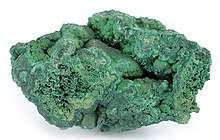Bayldonite
Bayldonite (BAIL-done-ite)[4] is a rare secondary mineral with the chemical formula PbCu3(AsO4)2(OH)2. It was first discovered in Penberthy Croft Mine, Cornwall, England, United Kingdom.[4] It is named after its discoverer, John Bayldon (1837(8) – 1872).[5] Specimens are also found in Tsumeb, Namibia, and Arizona, United States. It is sometimes used as a gemstone.[6]
| Bayldonite | |
|---|---|
 | |
| General | |
| Category | Arsenate minerals |
| Formula (repeating unit) | PbCu3(AsO4)2(OH)2 |
| Strunz classification | 8.BH.45 |
| Crystal system | Monoclinic |
| Crystal class | Prismatic (2/m) (same H-M symbol) |
| Space group | C2/c |
| Identification | |
| Color | Green, apple-green |
| Crystal habit | Mammillary crust |
| Mohs scale hardness | 4 1⁄2 |
| Luster | Resinous |
| Density | 5.24–5.65 g/cm3 (measured), 5.707 g/cm3 (calculated) |
| References | [1][2][3] |
References
| Wikimedia Commons has media related to Bayldonite. |
- Mineralienatlas
- "Bayldonite Mineral Data". Webmineral. Archived from the original on 7 June 2011. Retrieved 6 June 2011.
- "Bayldonite mineral information and data". Mindat. Retrieved 6 June 2011.
- Thomas, Arthur (2008). Gemstones: properties, identification and use. New Holland Publishers. p. 159. ISBN 978-1-84537-602-4.
- A. H. Church: XLI.—Chemical researches on some new and rare cornish minerals. In: Journal of the Chemical Society, 1865, 18, S. 259-268, doi:10.1039/JS8651800259.
- Gemstones: Properties, Identification and Use By Arthur Thomas, p.159
This article is issued from Wikipedia. The text is licensed under Creative Commons - Attribution - Sharealike. Additional terms may apply for the media files.